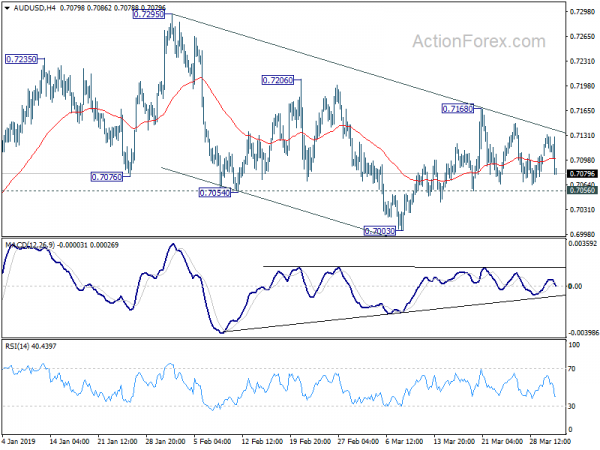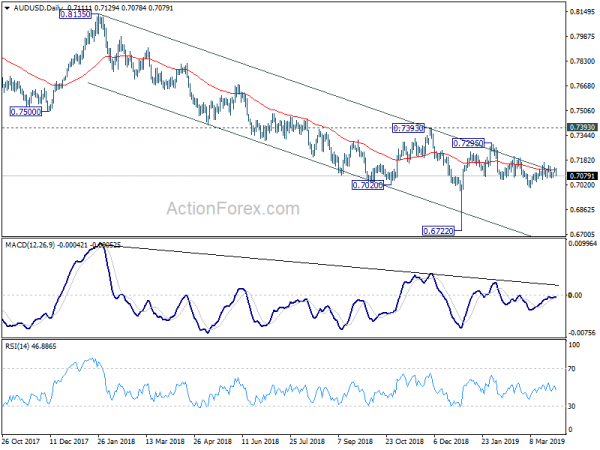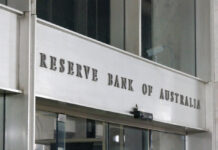Australian Dollar trading broadly lower today after RBA kept interest rate unchanged. While there was no clear dovish shift, the statement suggests that RBA is starting to get ready for a move. Weakness in Aussie takes New Zealand Dollar lower too. Sterling is the third weakest so far after UK Parliament rejected all Brexit alternatives again. As for today, Swiss Franc is the strongest so far, followed by Yen and than Dollar.
Technically, one development is note is the EUR/AUD recovers strongly after breaching 1.5721 low, suggesting recent consolidation is probably extending. Though, Euro is mildly vulnerable as EUR/USD is heading to 1.1176 low. Break will resume larger down trend from 1.2555 and could prompt selloff in Euro elsewhere. US 10-year yield jumped to close at 2.497 overnight, just missed 2.5 handle. USD/JPY rode on this and is on track to retest 112.13 resistance.
In Asia, Nikkei closed up 0.03%. Hong Kong HSI is up 0.12%. China Shanghai SSE is up 0.29%. Singapore Strati Times is up 0.68%. Japan 10-year JGB yield is up 0.0079 at -0.07. Overnight, DOW rose 1.27%. S&P 500 rose 1.16%. NASDAQ rose 1.29%. 10-year yield rose 0.083 to 2.497. to-year yield rose 0.068 to 2.890.
RBA kept cash rate at 1.50%, no dovish shift but hints on data dependency
RBA left cash rate unchanged at 1.50% as widely expected. There is one very subtle change in the statement that’s picked up by the markets. Back on March 5, RBA concluded by saying “Board judged that holding the stance of monetary policy unchanged at this meeting would be consistent with sustainable growth in the economy and achieving the inflation target over time.”
In today’s statement, RBA said “the Board judged that it was appropriate to hold the stance of policy unchanged at this meeting. The Board will continue to monitor developments and set monetary policy to support sustainable growth in the economy and achieve the inflation target over time.”
That is, RBA added some development-dependency on monetary policy. That hinted RBA could be ready to move in economic data warrant so and interest rate might not stay there for long. Given that markets are expecting two cuts this year, RBA’s change in statement is a small step affirming this view.
There are little changes in other parts of the statement though. RBA noted that GDP data paint a “softer picture” of the economy than job data. It acknowledged the mere 0.2% growth in Q4 and 2.3% over 2018. It also noted that “growth in household consumption is being affected by the protracted period of weakness in real household disposable income and the adjustment in housing markets.”
Employment and inflation outlook are unchanged. RBA expects “continued improvement in the labour market is expected to see some further lift in wages growth over time”, gradually. Inflation is expected to pick up gradually over the next couple of years. The central scenario is unchanged for inflation to hit 2% in 2019 and 2.25% in 2020.
UK parliament rejected all four Brexit alternatives again, but customs union option was close
Sterling weakened mildly as the UK House of Commons, unsurprisingly, rejected all four Brexit alternatives in yesterday’s indicative votes again. The closest one to get a majority was Conservative MP Kenneth Clarke’s Customs Union option, which was defeated 276-273. The most voted one was Labour Peter Kyle’s Confirmatory Public Vote, which was defeated 292-280.
Brexit Minister Steven Barclay complain in the Parliament after the votes that “this House has continuously rejected leaving without a deal just as it has rejected not leaving at all.” And he reiterated that ” the only option is to find a way through which allows the U.K. to leave with a deal.” He also noted “if the house were to agree a deal this week, it would still be possible to avoid holding European parliamentary elections.” It’s taken as a hint that Prime Minister Theresa May could put the thrice-defeated Brexit deal to a fourth vote this week.
BCC: UK businesses hitting the brakes hard on ongoing Brexit impasse
According to the British Chambers of Commerce’s quarterly economic survey, found that key indicators of UK economic health weakened considerably in Q1. In particular balance of services companies reporting rise in exports sales dropped to lowest in a decade. Balance of firms reporting improved cashflow turned negative for the first time since 2012. Also, investment intentions in manufacturing and services were at lowest in eight years.
BCC Director General Adam Marshall said “our findings should serve as a clear warning that the ongoing impasse at Westminster is contributing to a sharp slowdown in the real economy across the UK. Business is hitting the brakes – hard.” Also, “the prospect of a messy and disorderly exit from the EU is weighing heavily on the UK economy, and must still be avoided”
Marshall also complained that “for too long Brexit tunnel-vision has distracted government from fixing the fundamentals to support growth here in the UK.”
EU Juncker tells China: It can’t stay like this. It can’t work like this.
European Commission President Jean-Claude Juncker complained the practices of the bloc’s “systematic rivals” in front of lawmakers in Germany yesterday. He said “Chinese companies have free access to our markets in Europe, but we don’t to the markets in China”, and “it can’t stay like this”.
Also, “one country isn’t able to condemn Chinese human rights policy because Chinese investors are involved in one of their ports,” Juncker added “it can’t work like this”.
Though, he’s not against China’s Belt and Road initiative “as long as the conditions are right”. He said, “if you don’t only meet Chinese workers on these construction sites but also European workers, then this is all feasible.”
BoC Poloz: Recent data suggests below-potential growth just temporary
BoC Governor Stephen Poloz sounded confident in his speech yesterday. He noted that Canada is adjusting the challenges in the domestic and global economies. And after taking into account the structural adjustments to oil prices, he said “we can see many area of encouraging economic growth”.
He added that the global economy is performing less well than expected and “Canada is feeling the effects”. Housing markets is also taking longer to “digest the combined effect of stricter mortgage guidelines and higher interest rates”.
However, Poloz said “recent economic data have been generally consistent with our expectation that the period of below-potential growth will prove to be temporary.”
On the data front
Japan monetary base rose 3.8% yoy in March, below expectation of 4.4%. Australian building approvals jumped sharply by 19.1% mom in February versus expectation of -1.8% mom. Swiss will release CPI in European session. Eurozone will release PPI. UK will release PMI construction. Later in the data, US durable goods orders will be the main focus.
AUD/USD Daily Outlook
Daily Pivots: (S1) 0.7101; (P) 0.7117; (R1) 0.7130; More…
AUD/USD is staying in range between 0.7056 and 0.7168 and intraday bias remains neutral for the moment. On the downside, break of 0.7056 minor support will turn bias to the downside for 0.7003 first. Break will resume the whole decline from 0.7295. On the upside, break of 0.7168 will resume the rise from 0.7003 and turn bias to the upside for 0.7295 resistance. Break will extend the whole rebound from 0.6722 to 0.7393 key resistance level.
In the bigger picture, as long as 0.7393 resistance holds, we’d treat fall from 0.8135 as resuming long term down trend from 1.1079 (2011 high). Decisive break of 0.6826 (2016 low) will confirm this bearish view and resume the down trend to 0.6008 (2008 low). However, firm break of 0.7393 will argue that fall from 0.8135 has completed. And corrective pattern from 0.6826 has started the third leg, targeting 0.8135 again.
Economic Indicators Update
| GMT | Ccy | Events | Actual | Forecast | Previous | Revised |
|---|---|---|---|---|---|---|
| 23:50 | JPY | Monetary Base Y/Y Mar | 3.80% | 4.40% | 4.60% | |
| 0:30 | AUD | Building Approvals M/M Feb | 19.10% | -1.80% | 2.50% | 2.30% |
| 3:30 | AUD | RBA Rate Decision | 1.50% | 1.50% | 1.50% | |
| 6:30 | CHF | CPI M/M Mar | 0.40% | 0.40% | ||
| 6:30 | CHF | CPI Y/Y Mar | 0.50% | 0.60% | ||
| 8:30 | GBP | Construction PMI Mar | 49.7 | 49.5 | ||
| 9:00 | EUR | Eurozone PPI M/M Feb | 0.20% | 0.40% | ||
| 9:00 | EUR | Eurozone PPI Y/Y Feb | 3.10% | 3.00% | ||
| 12:30 | USD | Durable Goods Orders Feb P | -1.20% | 0.30% | ||
| 12:30 | USD | Durables Ex Transportation Feb P | 0.30% | -0.20% |















